Battery systems are found in both off-grid stand-alone PV systems and in battery-backed up, utility-interactive PV systems. See the March-April 2013 IAEI magazine for an overview of the battery-backed up, utility-interactive PV system. The following information will focus on the dc circuits associated with the battery system.
Types of Batteries
There are two main types of battery systems being used in PV systems at this time. Both are based on a lead acid battery technology [older than the National Electrical Code (NEC)]. The oldest technology uses a flooded lead acid battery that has removable vent caps and requires the addition of water on a regular basis. See photo 1. A related technology known as the valve-regulated, lead-acid (VRLA) battery uses an internal chemical design to allow the battery case to be effectively sealed. See photo 2. No water can be added to these VRLA batteries.
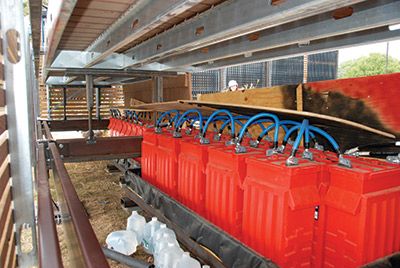
Photo 1. Flooded Lead Acid batteries
The newer battery types of nickel cadmium and lithium ion have not found their way into PV systems in any substantial numbers yet, probably due to the higher cost of these technologies. Increasing use of these battery types in electrical vehicles (EVs) will probably lower the costs and they will become more frequently used in PV applications. Other advanced technology battery types such as the chemical “flow” batteries are generally found only in large, experimental installations in utility and industrial applications.
Mechanical Installation, Venting and Acid Containment
Batteries contain substantial amounts of lead that makes them very heavy. The floor that they rest on must be sufficiently strong, particularly for the larger battery banks, which may weigh several tons. Where battery banks are installed in racks that are more than a foot or so high, those racks must be secured to a substantial wall. Building codes, especially in earthquake zones, require substantial mechanical securing of the batteries.
During the normal charging process, flooded lead acid batteries will emit hydrogen gas and sulfuric acid fumes into the surrounding environment. The type and adjustment of the charge controller will determine the amount of outgassing. Although the VRLA batteries are sealed, if the charge controller is misadjusted, becomes defective, or fails, the VRLA battery will also outgas hydrogen and sulfuric acid fumes. Both of these battery types should be installed in a well-ventilated area and should normally not be installed in a living space. In normal operation, the amount of hydrogen gas and sulfuric acid fumes are very limited and are quickly and easily dispersed into the surrounding room without problems. However, if these gases are restricted from being diluted with the surrounding air, an explosive combination of gases and air is possible. Garages and outbuildings are ideal locations for these batteries if they are well ventilated, not sealed, not used as living spaces, and do not have living spaces over them.
No attempt should be made to construct a manifold or venting system for these batteries. Power venting systems have a tendency to fail and the high-vent, low-vent system used for combustion appliances like gas furnaces and water heaters is not applicable to batteries since there is no driving energy source equivalent to the heat energy source of a heating system. Power vented manifolds on the batteries should not be used, as they have been responsible for explosions and fires in the past. Batteries installed in well vented locations are acceptable. Catalytic battery vent caps employing a platinum catalyst are available for use on flooded lead acid batteries to reduce hydrogen outgassing and reduce the requirement to add water to the battery.
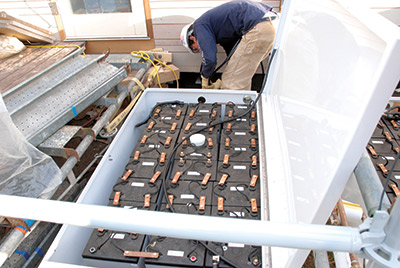
Photo 2. Valve Regulated Lead Acid (VRLA) batteries
Flooded lead acid batteries contain liquid sulfuric acid, and VRLA batteries include a similar jelled electrolyte. These batteries should be installed in a manner that prevents them from being mechanically abused. Many local building codes require some sort of acid containment for these batteries should the cases become cracked. Installing the batteries in an acid resistant outer container may be sufficient. Note the acid containment system under the batteries in photo 1. There are no generally available, certified/listed battery containers or battery boxes. For the smaller systems, it has been found that heavy-duty polyethylene toolboxes provides sufficient acid containment and also, with lockable tops, meet code requirements to prevent unqualified people from accessing the electrically energized battery terminals [690.72(B)(2)]. See photo 3.
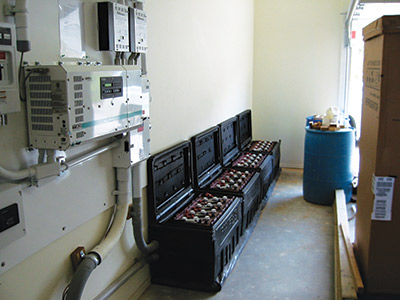
Photo 3. Flooded lead acid batteries in polyethylene containers
Location, Location, Location
In small and medium sized PV systems, the batteries operate at a nominal 12, 24, or 48 volts. To minimize voltage drop in the cables at the typical high operating currents, batteries are generally installed as close as possible to the loads that they serve. In PV systems these loads are usually a utility interactive inverter or a stand-alone inverter. In many cases, particularly in stand-alone systems, a power center is used which provides a central location for overcurrent protection, disconnects, and charge control functions. Even in the best of circumstances, it is generally not possible to mount and connect an overcurrent device or a disconnect any closer to the battery terminals than three or four feet.
Battery disconnects and overcurrent protection (either fused disconnects or circuit breakers) should not be installed very close to the batteries or inside any battery enclosure due to the potential evolution of hydrogen gas, which, when mixed with air can become an explosive mixture. Also the sulfuric acid fumes released from flooded lead acid batteries will be corrosive in nature and electrical components, other than properly protected cables, should not be in close proximity to these batteries (110.11).
When the batteries are located more than 4 – 5 feet from the utilization equipment, in a different room from the utilization equipment, or the cables must pass through a wall, those cables should be in conduit. The conduit should originate as close to the battery terminals as possible or at the battery container and then be routed all the way to the power center or other utilization equipment.
Cable Types and Sizes
THHN, RHW, THW and other commonly available cables listed in Chapter 3 of the code are acceptable for battery installations. Most commonly available plastic (thermoplastic) or rubber insulated (thermoset) cables are considered acid and moisture resistant.
The use of cables manufactured with type AWM or MTW conductors may not be accepted by AHJs because they are not typically used in fixed, code-compliant wiring systems.
Normal Class B and C stranded conductors can be used with certified/listed equipment that has the correct wire bending spaces. See NEC Chapter 9, Table 10. Unfortunately, not all equipment used with battery systems has been certified/listed and that equipment may have inadequate wire bending space. This has caused many installers to use a fine stranded, flexible cable-like welding or automotive battery cable; and these cables do not comply with NEC requirements for fixed, non-mobile, battery installations. Code-compliant cable types such as THHN, RHW, and THW are available in fine stranded, flexible configurations. However, the use of fine stranded flexible cables may pose termination issues. See NEC 110.14, 690.74, photo 4 and “Perspectives on PV” in the January–February 2005 IAEI News.
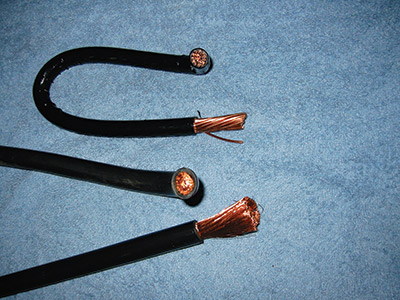
Photo 4. Class B stranded cables, top; fine stranded cables, bottom
Note a slight problem in the Code in 690.74. Single-conductor flexible cables are generally not available certified/listed for hard service duty. To be corrected in 2017.
Some “manufactured” battery cables may not have the proper terminals where fine stranded flexible cables have been used and are questionable even when a code-complaint cable type has been used. Without the proper terminations, the cables may fail at the terminations at some later date.
The cables must be sized based on the continuous current requirements that will be based on charging currents from either the PV array or an inverter/charger or on discharging currents, usually to the inverter. Depending on the system design, there may be more than one circuit connected to the battery – one circuit for charging, and one circuit for discharging. Where there is a single circuit used for both charging and discharging, the cable must be sized on the largest continuous current in either mode. Although the Code typically requires that conductors be sized and protected based on continuous (3 hours or more) loads, battery based systems may require a slightly different approach. With stand-alone, off-grid inverters, the inverters have a substantial capability to surge currents above their steady-state rating for periods of minutes to an hour, and this may create voltage drop in the cables that poses operational problems. In this case, voltage drop calculations must also be made to ensure that the inverter will operate properly under all conditions of continuous use and surges.
Battery banks connected with sets of series-connected cells or batteries and parallel sets of cells or batteries should be wired so that the length of cables (and the resulting resistance) would be the same for each series connection to minimize charging and discharging current and voltage imbalances and premature cell/battery failure. See figure 1.
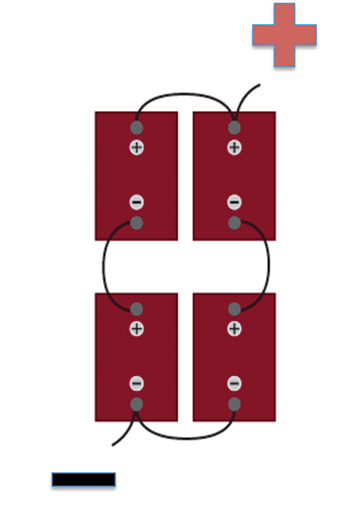
Figure 1. Series-parallel battery connections. Note: Current travels through equal lengths of conductors in each of the series paths. Battery cables should be the same size and length in each path. All terminations should be identical. Credit Trojan Battery Co.
Overcurrent Protection
Batteries can source high fault currents. It is somewhat difficult to obtain specific short-circuit current data on batteries and even more difficult to determine what those short-circuit currents may be at the output of the battery bank which may consist of numerous series and parallel connected individual batteries. Tests and estimates made several decades ago indicate that for typical residential and small commercial battery banks, the inter-cell/inter-battery connectors, the battery cables, the contact resistances, and other factors will typically limit the available short-circuit current at the output of the battery bank to less than 15,000 A. Therefore, any overcurrent device protecting these cables should have an interrupt rating of at least 15,000 A. Both dc rated fuses and dc rated circuit breakers with that rating are available.
DC rated, current-limiting fuses are commonly available and will provide some protection for downstream components. DC rated circuit breakers, on the other hand, have little or no current limiting capabilities. Any equipment in the dc battery conductor path should have sufficient short-circuit interrupt capabilities where circuit breakers are used.
Normally, in small residential and small commercial battery banks, the individual strings (series connected cells/batteries) of batteries are not fused. Series and parallel connections are made within the battery bank and then the overall output is provided with overcurrent protection. This would generally indicate that the cables within the battery bank be able to handle the entire current of the battery bank (and not be sized to handle just a proportional part of the total battery current). In parallel connected sets of batteries or cells the individual cells and batteries may not age at the same rate and the currents may tend to be higher in some of the series connections than in others. For that reason, it is somewhat difficult to fuse individual strings of batteries because they may be required to carry more and more current as other strings of batteries age and carry less current. Also installing an overcurrent device inside the battery bank on a single string or several strings poses both maintenance and potentially explosion hazards.
In larger battery installations (where room size battery banks are involved) individual strings of batteries or cells may have a fused disconnect on each string. That fused disconnect must be located in an area that allows easy access and is not subject to hydrogen gas/sulfuric acid fumes. The size of the conductors for each battery string and the overcurrent device rating require careful consideration because of the potential for unequal currents in the battery series circuits as the battery bank ages.
Part VIII of NEC Article 690 has numerous requirements that are relatively clear that apply to battery installations.
Proper maintenance of the battery banks is the key to maintaining battery longevity and keeping the various currents balanced.
The batteries are able to generate more short-circuit current than the typical charging source and there should be an overcurrent protection device near the batteries. The overcurrent device has to be sized at least at 125% of the continuous current (either charge or discharge, whichever is greater) and if the charging currents are greater than the discharging currents, an overcurrent device may be required at the charging source.
A disconnect may be required at the battery to not only service the fuse (a circuit breaker includes the disconnect), but also to provide a method of disconnecting the battery circuit from other connected devices.
Fuses that bolt directly to the battery terminals are generally not acceptable in code-compliant installations because they are very difficult for unqualified people to service on the always-energized battery terminals.
Summary
Plan reviewers and inspectors should check battery installations for substantial mechanical installation, correct cable types and sizes, proper placement and rating of overcurrent devices and disconnects, good conduit installation techniques, and proper ventilation.
For More Information
The author has retired from the Southwest Technology Development Institute at New Mexico State University, but is devoting about 25% of his time to PV activities in order to keep involved in writing these Perspectives on PV articles in the IAEI News and to stay active in the NEC and UL Standards development. He can be reached, sometimes, at: e-mail: jwiles@nmsu.edu, Phone: 575-646-6105
The Southwest Technology Development Institute web site maintains a PV Systems Inspector/Installer Checklist and all copies of the previous “Perspectives on PV” articles for easy downloading. A color copy of the latest version (1.93) of the 150-page, Photovoltaic Power Systems and the 2005 National Electrical Code: Suggested Practices, written by the author, may be downloaded from this web site: http://www.nmsu.edu/~tdi/Photovoltaics/Codes-Stds/Codes-Stds.html
It should be updated to the 2008 and 2011 NEC before the 2014 NEC arrives.










Find Us on Socials